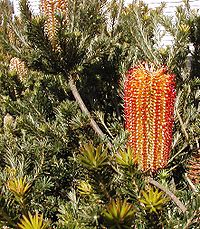
Photo from wikipedia
The South African Cape fynbos heath Erica coccinea subsp. coccinea is polymorphic for post-fire regeneration mode (seeder/resprouter), flower colour (red/yellow), flowering time (summer-autumn/winter-spring), as well as anther size. These polymorphisms… Click to show full abstract
The South African Cape fynbos heath Erica coccinea subsp. coccinea is polymorphic for post-fire regeneration mode (seeder/resprouter), flower colour (red/yellow), flowering time (summer-autumn/winter-spring), as well as anther size. These polymorphisms tend to occur between, rather than within, populations. Here, we aimed to understand flower colour divergence in this fynbos heath species and its association with post-fire regeneration. We tested for an association between these polymorphisms. We also examined whether yellow-flowered plants lacked anthocyanins and whether the lack of anthocyanins affected the concentration of other flavonoids, both in flowers and shoots. We found a strong association between flower colour, regeneration mode and flowering phenology. We also detected larger anthers and larger pollen in yellow- than in red-flowered plants, consistently for both resprouter and seeder regeneration strategies. Finally, we ascertained that being yellow-flowered is associated with loss in the capacity of synthesizing anthocyanins in both the flower and in the vegetative tissue. Considering that pollinator availability or preferences do probably not constitute a selection pressure, we propose that both enhanced reproductive success of anthocyaninless, yellow-flowered plants and the avoidance of likely negative pleiotropic effects (early senescence) in seeders would be key to understanding the flower colour divergence in E. coccinea subsp. coccinea.
Journal Title: Evolutionary Ecology
Year Published: 2019
Link to full text (if available)
Share on Social Media: Sign Up to like & get
recommendations!